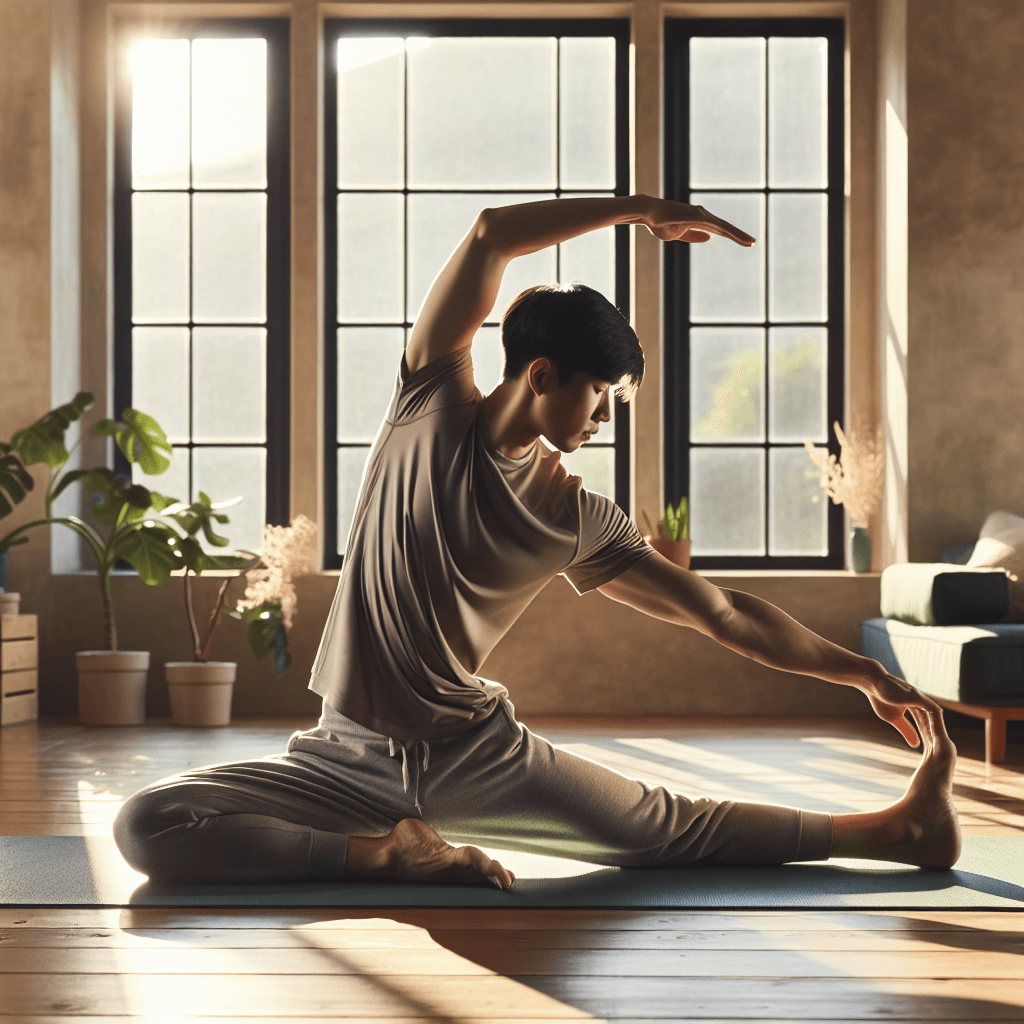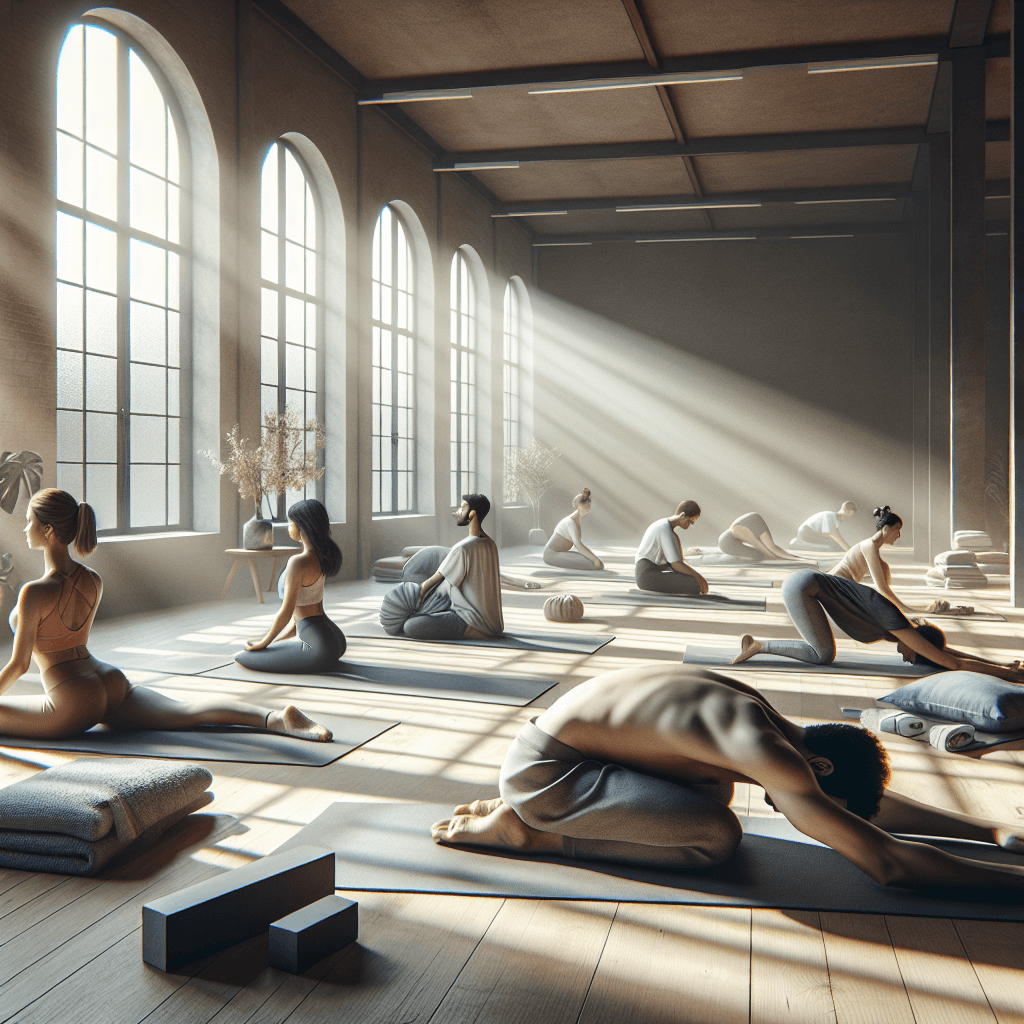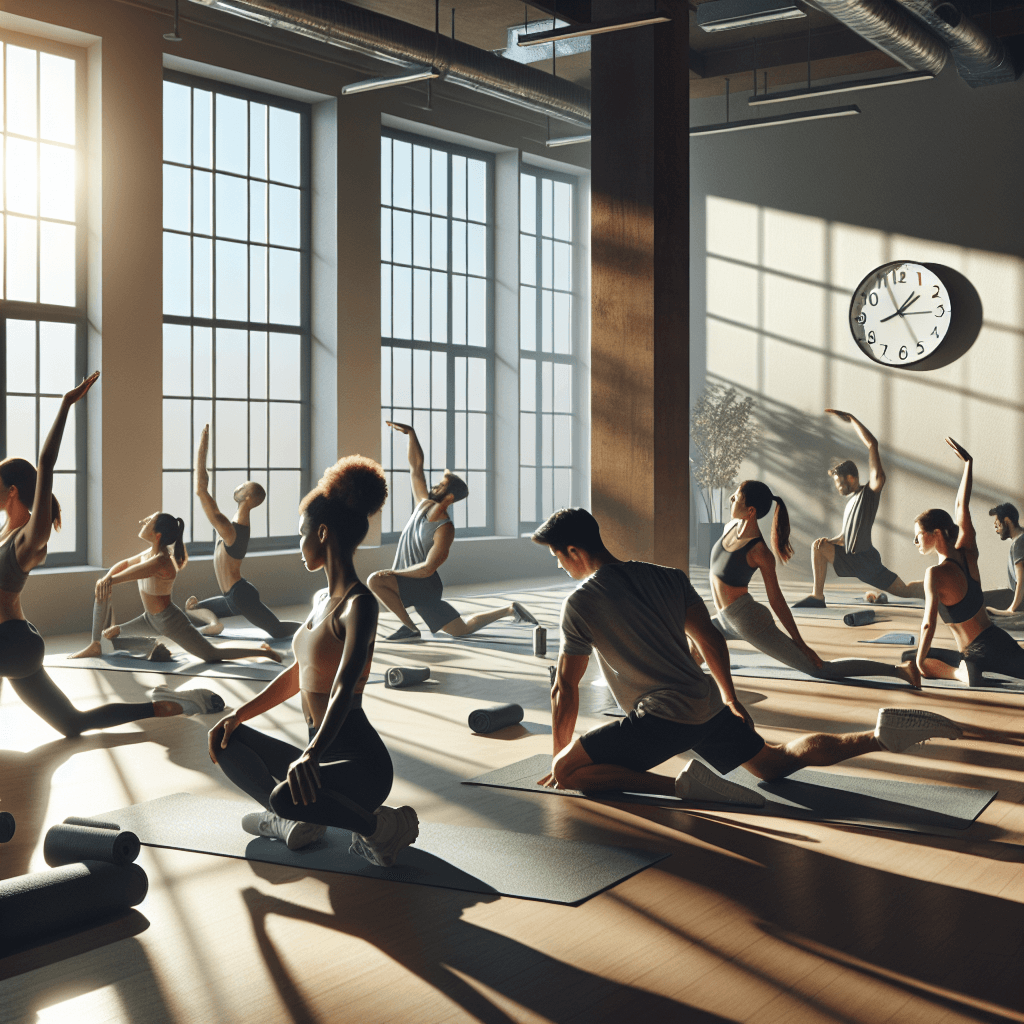Regular stretching sessions, split between morning and evening, boost flexibility and ease muscle tension daily. This approach, paired with controlled breathing and correct form while sustaining each position for 15–30 seconds, sets up better mobility and muscle recovery.
Key Takeaways
- Combine dynamic stretches before workouts and static stretches afterward for optimal results
- Maintain proper form and breathe steadily through each stretch, holding positions for 15–30 seconds
- Schedule regular stretch breaks during desk work to prevent muscle stiffness
- Listen to your body and avoid pushing into sharp pain during stretches
- Incorporate props like yoga blocks or resistance bands to support proper alignment and deepen stretches
Morning and Evening Stretching Benefits
I’ve found that starting each day with simple stretches wakes up my muscles and gets my blood flowing. My evening routine helps release accumulated tension and prepares my body for restful sleep. This dual approach maximizes the benefits of stretching while fitting naturally into daily life.
Technique and Attention to Form
Small adjustments in technique make big differences. I focus on steady breaths and correct positioning rather than forcing stretches too far. This careful attention prevents injury and builds lasting flexibility gains. Props add extra support when needed, making challenging stretches more accessible and effective.
Stretching Breaks During Work
Breaking up long periods of sitting with brief stretch sessions keeps my muscles loose and my mind alert. These mini-breaks prove especially valuable during intense work periods at my desk.
Essential Morning Stretches Targeting Major Muscle Groups
Starting my day with targeted stretches helps kickstart blood flow and loosens tight muscles. A proper morning stretch routine can make a huge difference in how my body feels throughout the day.
Key Morning Stretches for Full-Body Flexibility
Before diving into specific stretches, I’ll remind you to breathe deeply and steadily through each movement. Every stretch should be held for 15-30 seconds while maintaining proper form.
Here are the essential stretches I recommend for your morning routine:
- Hamstring Stretch – Sit with legs extended, reach for toes while keeping back straight
- Cat-Cow Pose – On hands and knees, alternate between arching and rounding spine
- Standing Quad Stretch – Hold one foot behind you while standing, keeping knees aligned
- Shoulder Rolls – Roll shoulders backward and forward to release upper body tension
- Cross-Body Arm Stretch – Pull each arm across chest to target shoulder muscles
- Standing Side Bend – Reach one arm overhead, lean sideways for lateral stretch
- Hip Flexor Lunge – Step forward into lunge position, sink hips forward
I find that combining these stretches creates an effective full-body morning routine that takes just 10-15 minutes. The key is staying consistent and listening to your body’s signals. If you feel any sharp pain during these stretches, ease off immediately and adjust your form.
Keep your movements slow and controlled — rushing through stretches can lead to injury rather than improvement. I make sure to focus on my breathing pattern, inhaling deeply through my nose and exhaling slowly through my mouth during each stretch.
These stretches work best when done in a quiet space where I can concentrate on proper form and alignment. By paying attention to how my body responds, I can adjust the intensity of each stretch to match my flexibility level that particular morning.
Morning stretching isn’t about forcing my body into extreme positions. Instead, I aim for gentle, progressive stretching that gradually improves my range of motion over time. This patient approach helps prevent injury while still delivering all the benefits of a regular stretching practice.

Key Stretches to Maximize Your Flexibility and Prevent Injury
Essential Stretching Sequence
Starting with Child’s Pose lets you gently open your lower back and shoulders while calming your mind. I recommend holding this position for 30-60 seconds while taking deep breaths and letting your body sink deeper into the stretch.
The Cat-Cow sequence creates fluid movement through your spine, helping to improve mobility and reduce stiffness. By moving between these poses 5-10 times, you’ll wake up the muscles along your spine and prepare for deeper stretches.
A Standing Forward Fold targets those often-tight hamstrings while also releasing tension in your lower back. Don’t force yourself to touch your toes — keeping a slight bend in your knees helps maintain proper form and prevents strain.
Downward Dog serves as an incredible full-body stretch, targeting multiple muscle groups simultaneously. Press your heels toward the ground and lengthen through your spine to maximize the benefits of this pose.
Lunges open up tight hip flexors, which can become shortened from long periods of sitting. Step one foot forward and sink your hips down and forward to feel this powerful stretch.
Customizing Your Stretching Practice
Here are key ways to modify these stretches based on your current flexibility:
- Use props like yoga blocks or pillows to support your body in challenging positions
- Bend your knees generously in forward folds if your hamstrings feel tight
- Keep movements small and controlled when first starting out
- Hold stretches for shorter durations if you’re just beginning
- Place a blanket under your knees for added comfort in poses like Child’s Pose
I find that maintaining steady breathing throughout each stretch helps deepen the release and prevents muscle tension. Remember to move slowly between positions and never force your body into pain — mild discomfort is normal, but sharp pain means you should back off the stretch.

Timing Your Stretches for Maximum Benefits
Setting the Right Duration for Different Stretches
Static stretches need to be held for 15-30 seconds to effectively lengthen your muscles and improve flexibility. I recommend starting with 15 seconds per stretch and gradually increasing the duration as your flexibility improves. For dynamic stretches, like leg swings or arm circles, I suggest doing 10-12 controlled repetitions on each side.
Knowing when to perform different types of stretches can make a significant difference in your workout performance and recovery. Here’s my recommended timing breakdown:
- Before workouts: Focus on dynamic stretches to warm up your muscles and increase blood flow
- During workouts: Quick stretches between sets if needed, lasting 5-10 seconds
- After workouts: Static stretches while your muscles are warm, holding for the full 15-30 seconds
- On rest days: Mix of both dynamic and static stretches to maintain flexibility
A complete stretching routine should take 10-15 minutes — that’s enough time to target all major muscle groups without rushing through the movements. I find this duration strikes the perfect balance between effectiveness and time efficiency.
Daily stretching delivers the best results for improving and maintaining flexibility. Even on busy days, I encourage doing a quick 5-minute routine rather than skipping it entirely. Being consistent with stretching, even for shorter durations, helps prevent muscle tightness and reduces injury risk.
For optimal results, pay attention to your breathing during each stretch. Take slow, deep breaths and avoid holding your breath. This helps your muscles relax and allows for a deeper stretch. Remember to stretch both sides of your body equally to maintain proper muscle balance.

Warning Signs and Safety Precautions
Understanding Pain vs. Discomfort
I can’t stress enough the importance of distinguishing between productive stretching sensations and harmful pain. A good stretch should feel like mild tension or pulling – never sharp, stabbing, or burning. Stop immediately if you experience any shooting pains, particularly in your joints or along nerve pathways. This is your body’s way of signaling potential damage.
Key Safety Guidelines
Before starting any stretching routine, I recommend warming up your muscles with 5-10 minutes of light cardio. Here are critical mistakes to watch out for:
- Bouncing or jerking movements during stretches
- Pushing too hard too fast
- Stretching cold muscles
- Holding your breath while stretching
- Ignoring persistent pain or discomfort
Your body needs special attention if you have pre-existing conditions. I strongly advise getting clearance from your healthcare provider before starting a stretching routine if you have:
- Recent injuries or surgeries
- Chronic joint conditions
- Osteoporosis
- Muscle tears or strains
- Hypermobility disorders
Schedule an appointment with a healthcare professional if you notice any of these warning signs during or after stretching:
- Pain that lasts more than an hour after stretching
- Recurring sharp pain in specific areas
- Joint instability or clicking sounds
- Numbness or tingling sensations
- Decreased range of motion
Remember to start gradually and build up your flexibility over time. I find it’s better to stretch more frequently with gentle intensity than to push too hard in a single session. Listen to your body’s signals and adjust your routine accordingly.
Advancing Your Stretching Practice
Setting Flexibility Milestones
I recommend starting with clear, measurable goals to improve your flexibility journey. Setting specific targets, like touching your toes or achieving a full split, helps track progress effectively. Rather than rushing to meet these goals, focus on gradual progression through consistent practice.
The key to advancing your stretches lies in proper form and controlled movements. Take basic stretches to the next level by adding dynamic elements — for instance, transform a standard hamstring stretch into a flowing forward fold with gentle bounces. For the shoulders, progress from simple arm circles to more challenging mobility drills.
Enhanced Stretching Techniques
Partner stretching adds a new dimension to flexibility training. Having a trusted partner can help you achieve deeper stretches while maintaining safety. Here are essential partner stretching exercises to incorporate:
- Back-to-back seated twists for spinal mobility
- Assisted hamstring stretches while lying down
- Standing forward fold with gentle partner pressure
- Supported bridge pose for deeper backbends
- Assisted shoulder stretches with resistance bands
Props and equipment can significantly boost your stretching routine. Simple items like resistance bands, foam rollers, and yoga blocks open up possibilities for deeper, more effective stretches. A resistance band can assist in shoulder mobility work, while a foam roller helps release tight muscles before stretching.
To monitor your progress, I suggest taking monthly flexibility assessments. Document your current range of motion using photos or videos, measuring specific angles in key positions. Keep a stretching journal to note which techniques work best for your body and track improvements over time. This data helps adjust your routine for optimal results and maintains motivation as you see tangible progress.
Remember to breathe deeply during each stretch, holding positions for 30–60 seconds to allow muscles to lengthen properly. As you advance, incorporate active flexibility work — contracting muscles while in stretched positions — to build both flexibility and strength simultaneously.
Incorporating Stretching Into Your Daily Routine
Morning stretches kickstart your day by increasing blood flow and improving mobility, while evening stretches help release tension and prepare your body for restful sleep. I’ve found that consistent stretching at these key times makes a significant difference in reducing muscle tightness and improving overall flexibility.
Key Times to Stretch During Your Day
Starting your morning with gentle stretches gets your muscles ready for daily activities. Here are strategic times to include stretches throughout your day:
- First thing in the morning: Focus on full-body stretches like cat-cow poses and gentle twists to wake up your spine
- During office hours: Stand up every hour to do shoulder rolls, neck stretches, and ankle rotations
- Pre-workout: Dynamic stretches like leg swings and arm circles prepare your muscles for exercise
- Post-workout: Hold static stretches for 15-30 seconds targeting the muscles you just used
- Before bed: Light stretching helps release the day’s tension – try child’s pose or lying spinal twists
If you spend long hours at a desk, regular stretch breaks are vital. I recommend setting hourly reminders to stand up and do simple desk stretches. Raise your arms overhead, roll your shoulders back, and gently turn your head from side to side. These quick movements help prevent stiff muscles and maintain good posture.
Dynamic stretching before exercise preps your body for movement. Try walking lunges, high knees, and arm circles for 5-10 minutes. This increases your heart rate gradually while improving your range of motion.
After working out, static stretching aids recovery by gradually lengthening warm muscles. Hold stretches targeting your quadriceps, hamstrings, calves, and any other muscles used during exercise. Keep the stretches gentle — you should feel a light pull but never pain.
Mini-stretch breaks throughout your day maintain flexibility and reduce muscle tension. Even 60 seconds of stretching can refresh your body and mind. Simple moves like shoulder shrugs or ankle rotations can be done anywhere, whether you’re at your desk, in line at the store, or watching TV.
Remember to breathe deeply during all stretches. This helps oxygen flow to your muscles and enhances the stretching benefits. The key is making stretching a natural part of your daily habits rather than viewing it as another task to complete.
Sources:

Pingback: How Long Does It Take To See The Benefits Of Stretching?
Pingback: Where To Begin With Stretching?
Pingback: What Are The 5 Benefits Of Stretching?
Pingback: What Will Happen If I Do Stretching Everyday?
Pingback: Is It Better To Stretch At Night Or Morning?
Pingback: How Long Should I Stretch Everyday For Beginners?
Pingback: What Body Part Should I Stretch First?